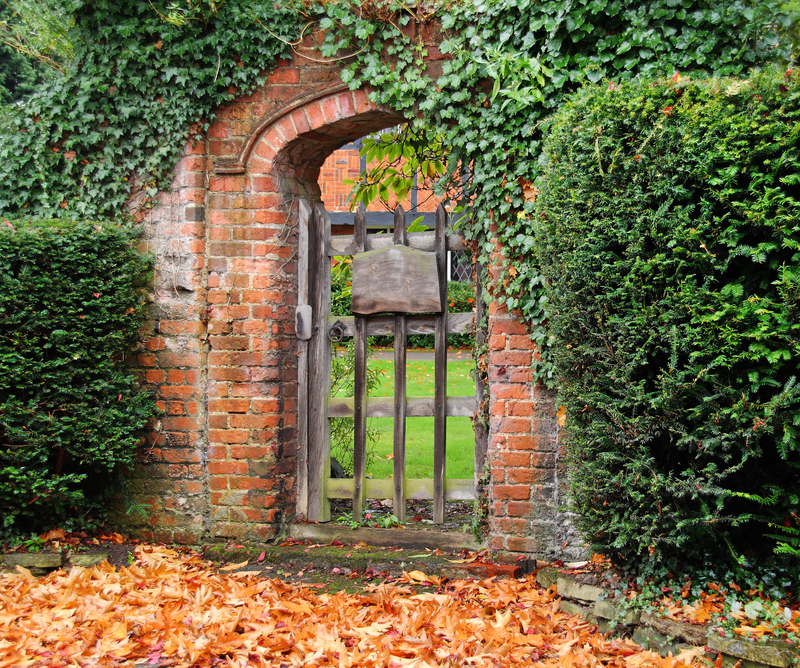First Steps to Breathe Life into Your Untended Garden
Posted on 30/08/2025
First Steps to Breathe Life Into Your Untended Garden
Is your once-vibrant garden looking more like a jungle these days? Or maybe you've inherited a neglected plot bursting with wild, untrimmed growth. Whatever the reason, breathing life into an untended garden is a rewarding experience that reconnects you with nature and transforms your outdoor space. In this comprehensive guide, we'll walk you through the essential steps to revive your overgrown, forgotten patch into a flourishing, healthy garden once again.

Why Restore an Untended Garden?
Bringing back your forgotten garden offers more than just aesthetic appeal. Reviving an untended garden improves biodiversity, increases your property's value, and provides a haven for relaxation and recreation. Whether you are a seasoned green thumb or a beginner, learning the first crucial steps to breathe life into your untended garden will set you on the path toward a vibrant and sustainable backyard.
Assessing Your Garden: Take Stock of the Jungle
Before grabbing your tools, it's vital to understand what you're working with.
- Evaluate the State of the Garden: Walk around and take notes. Identify which plants are worth saving and which areas need the most work.
- Photograph the Space: Documenting the untended garden will help you track your progress and plan improvements.
- Soil Check: Dig a small hole to inspect your garden's soil condition. Healthy soil is the foundation for a thriving garden.
- Consider Sun and Shade Patterns: Identify areas of full sun, partial shade, and deep shade. This helps when selecting new plants or repositioning old ones.
Observation is your first tool. You may discover hidden gems--resilient perennials, self-sown annuals, or mature shrubs that can become focal points in your restored garden. Making detailed notes ensures your efforts are purposeful and targeted toward your untended plot's unique needs.
Clearing the Chaos: Removing Weeds, Debris and Overgrowth
Restoration begins with reclaiming space from weeds, dead material, and debris.
- Weed Thoroughly: Start by removing invasive and unwanted plants. Dig out roots to prevent regrowth.
- Clear Debris: Rake up leaves, branches, and litter. Dispose of any trash or broken garden ornaments.
- Trim Overgrown Shrubs and Trees: Prune dead or tangled branches. This not only shapes the plants but also encourages healthy regrowth.
- Mow Your Lawn: If the grass is waist-high, tackle it slowly. Mow a little at a time to avoid shocking the lawn or damaging your mower.
Tip: For heavily overgrown gardens, tackle one section at a time to avoid feeling overwhelmed. This phased approach makes the process more manageable and maintains your motivation to continue breathing life into your long-neglected garden.
Soil Revitalization: Laying the Foundation
Healthy soil is the key ingredient in your recipe for a thriving garden. Years of neglect can leave soil compacted, depleted, and devoid of nutrients. Here's how to nurse your soil back to life:
- Aerate and Loosen the Soil: Use a fork or tiller to break up compacted earth. This helps roots grow and allows water to penetrate deeper.
- Test Soil Health: Purchase a basic soil test kit from your garden center. Knowing your soil's pH and nutrient levels will guide your next steps.
- Amend with Organic Matter: Add compost, well-rotted manure, or leaf mold. These boost fertility and improve the soil's structure.
- Mulch Generously: Cover soil with a layer of mulch to suppress new weeds, retain moisture, and enrich the ground as it decomposes.
Enriching your soil is a vital first step to breathe life into your untended garden, supporting the robust growth of both existing and new plantings.
Preserve or Remove: Deciding Which Plants to Keep
Every untended garden tells a story. Some plants may have survived neglect and could become the backbone of your new design. Others, however, may need to go.
- Identify Survivors: Look for perennials and shrubs that are healthy and not invasive. They can be pruned and incorporated into your rejuvenated space.
- Remove Aggressive Invaders: Certain weeds and plants spread rapidly and out-compete desired species. Remove them carefully and thoroughly.
- Relocate or Divide Crowded Plants: If you have multiple of the same plant competing for space, consider dividing or moving them to a new spot.
- Revive Ailing Plants: Sometimes a good prune and fresh mulch are all an older, straggling shrub needs.
Remember: Saving mature, resilient plants helps root your new garden in history and offers instant structure as you bring your untended plot back to life.
Basic Design Planning: Map Your Revived Garden
Once your garden is cleared, take a step back and imagine its possibilities. Planning ensures that any effort you invest now will pay off with a functional layout and cohesive planting scheme later.
- Sketch a Simple Plan: Draw your garden's outline, noting the locations of trees, structures, sun, and shade.
- Define Areas and Functions: Do you want a vegetable patch, seating area, or wildlife corner? Allocate space accordingly.
- Select Easy-Care Plants: Choose varieties adapted to your climate, soil, and light levels. Natives and drought-tolerant species are less work and more resilient.
- Plan for Four Seasons: Add evergreens, bulbs, and plants with year-round interest to avoid another cycle of neglect.
Putting pen to paper helps clarify your vision and guides your planting and purchasing decisions, making the process of restoring your untended garden even more enjoyable.
Start Planting: New Life for an Old Garden
Armed with a plan, revitalized soil, and cleared space, you're ready for the most exciting step: planting! Here's how to make a strong start:
- Begin with Structure: Plant trees and shrubs first. They form the backbone of your garden and provide privacy, shade, and habitat.
- Add Perennials and Bulbs: These fill borders with long-lasting color and interest, returning each year with minimal care.
- Fill in with Annuals: Fast-growing annuals add a burst of color and can fill gaps while slower plants establish themselves.
- Water Wisely: Give new plants a thorough watering, especially during the first few weeks. Mulch to retain moisture and suppress emerging weeds.
Tip: Don't try to do everything at once. Focus on one area at a time, enjoying each zone as it comes back to life. This phased approach prevents burnout and ensures you enjoy the journey as much as the results.
Composting and Mulching: Nature's Recyclers
As you clean and prune your untended garden, you'll generate plenty of green waste. Don't throw it all away! Composting is the most eco-friendly way to recycle plant material, returning valuable nutrients to your garden.
- Set Up a Compost Bin: Use garden waste, leaves, vegetable peels, and coffee grounds to create rich, crumbly compost over time.
- Mulch Liberally: Apply leaf mold, bark, or even grass clippings as mulches. They suppress weeds, hold moisture, and feed your soil as they break down.
Composting and mulching are essential steps in the process to breathe life into your uncared-for garden, closing the nutrient cycle and ensuring long-term health.
Invest in Essential Gardening Tools
Restoring an untended garden is much easier with the right equipment. Consider these basic tools as you embark on your rescue mission:
- Sturdy Gloves: To protect your hands from thorns and debris.
- Spade or Fork: For digging and soil amendment.
- Pruning Shears and Loppers: For cutting back dead wood and overgrowth.
- Wheelbarrow: Makes moving soil, mulch, and waste more efficient.
- Rake and Hoe: For clearing and smoothing beds.
Investing in quality tools saves you time and prevents injury, making the transformation of your untended garden smoother and safer.
Maintaining Your Restored Garden: Tips for Lasting Success
A garden is a living system that will continue to evolve and grow. Once you have breathed new life into your abandoned or untended garden, regular care will keep it thriving:
- Weed Little, Weed Often: A few minutes a week keeps invasive plants at bay.
- Water Regularly, Especially During Dry Spells: Early morning is best to avoid evaporation and fungal diseases.
- Feed Your Plants: Use organic fertilizers or additional compost to promote lush growth and blooms.
- Watch for Pests and Diseases: Early detection prevents widespread damage and ensures a healthy, balanced garden.
- Seasonal Pruning: Prune dead or diseased material in winter and shape your plants to keep them healthy and attractive.
With consistent care, even the most neglected garden will flourish--rewarding you with color, fragrance, and wildlife year-round.
Eco-Friendly Tips to Sustain Your Garden's Rebirth
Sustainability is a key principle in modern gardening. Build an eco-friendly garden as you bring yours back to life by:
- Planting Natives: Native plants require less water and are less prone to pests and diseases.
- Encouraging Wildlife: Install bird feeders, plant wildflowers, and provide shelter for beneficial insects.
- Collecting Rainwater: Use water butts or barrels to reduce water consumption.
- Using Natural Mulches and Fertilizers: Avoid chemicals by utilizing your homemade compost and mulches.
This approach helps your renewed garden stay healthy while benefiting the local ecosystem and reducing your maintenance workload in the long run.

Common Challenges (And How to Overcome Them)
Reviving an untended garden is not without its obstacles. Here's how to tackle some common issues:
- Soil Problems: If your soil is heavy clay, sandy, or compacted, regular additions of organic matter and mulch will gradually improve structure and fertility.
- Invasive Weeds: Persistent weeds may take several seasons to subdue. Stay diligent, mulch heavily, and remove weeds before they set seed.
- Disease and Pests: Remove affected plants early, encourage natural predators, and choose disease-resistant plant varieties.
- Lack of Time: Focus on low-maintenance plants and manageable garden sections. Remember, progress over perfection!
Tackling these challenges systematically will ensure your garden restoration is both enjoyable and ultimately successful.
Celebrate Your Garden's Revival!
Restoring an untended garden is a journey of patience, discovery, and creativity. As you take these first steps to bring life back to your garden, you'll soon see new shoots, buzzing pollinators, and unexpected beauty emerging from every corner.
- Share Your Progress: Keep a garden journal or share updates on social media to inspire others.
- Host a Garden Party: Invite friends and family to enjoy your revitalized outdoor space.
- Keep Learning: Gardening is a lifelong skill. Try new plants, techniques, and designs as you gain confidence.
The first steps to breathe life into your untended garden mark the beginning of an evolving adventure. Before long, your once-overlooked patch of earth will become a nurturing, thriving sanctuary--for you, your loved ones, and your local wildlife.
Conclusion: Your Revived Garden Awaits
With the right approach and some perseverance, anyone can transform an abandoned, overgrown plot into a beautiful, productive garden once more. Start by assessing the space, clear and revitalize your soil, preserve valuable plants, and work steadily toward a resilient design. By following these comprehensive first steps to breathe life into your untended garden, you'll enjoy an outdoor oasis brimming with beauty, vitality, and personal satisfaction. So grab your gloves and shovel--the journey back to garden greatness begins today!

